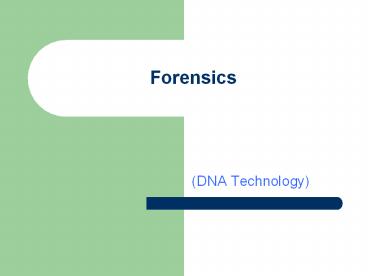Forensics - PowerPoint PPT Presentation
1 / 9
Title:
Forensics
Description:
DNA is the carrier of genetic information and provides a structural plan for proteins. ... someone is a suspect, should forensic teams be allowed to collect DNA ... – PowerPoint PPT presentation
Number of Views:45
Avg rating:3.0/5.0
Title: Forensics
1
Forensics
- (DNA Technology)
2
What is DNA?
- DNA is the carrier of genetic information and
provides a structural plan for proteins. - It consists of linear linked nucleotides whose
sequence forms hereditary. - The DNA is in the form of a double helix and is
made up of four bases adenine, thymine, cytosine
and guanine.
3
DNA Uses for Forensic Identification
- DNA is used in forensics to
- Identify potential suspects if their DNA matches
DNA found at crime scene - Prove possible innocence of people wrongly
accused of crime - Identify crime and catastrophe victims
- Show paternity and other family relationships
- Identify endangered/protected species (can be
used to prosecute poachers) - Detect bacteria polluting air, soil, water, food
- Match organ donors with organ receivers
- Determine pedigree
4
Solving Crimes
- DNA can be used to identify criminals with
incredible accuracy when biological evidence
exists. - Still not used to convict people for a long time
as juries didnt understand how the DNA evidence
proved anything. - Samples could be contaminated easily.
5
Fingerprinting
- Any type of organism can be identified by
examination of DNA sequences. To identify
individuals, 13 DNA regions are scanned. Each
region varies from person to person. The unique
data provided by an individual is used to create
a DNA profile which is also known as their
fingerprint. There is an extremely small chance
that another person has the same DNA profile for
a particular set of regions.
6
CODIS Database
- The COmbined DNA Index System
- A database containing DNA collected from crime
scenes - Has DNA profiles of individuals convicted of
felony sex offences and other violent crimes - Uses computer software to search the DNA profiles
to match biological evidence gathered at crime
scenes.
7
Moral Problems
- Having DNA contained in a national database
breaches confidentiality rights and the privacy
of an individual - If someone is a suspect, should forensic teams be
allowed to collect DNA samples without the person
knowing? - Can DNA from dead persons be collected or
registered, as they cannot be suspected or
prosecuted?
8
Future Applications
- To have everybodys DNA and fingerprint on a
database - This comes back to Moral Issues, some people feel
it is against their rights to have their DNA and
fingerprints on file. - Although this could prevent most crimes from
happening in the first place as if everybodys
DNA and fingerprints are on file the offender is
more likely to be caught.
9
The End
- Thanks for your time!
- Any Questions?































